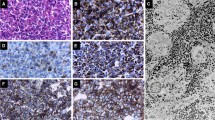Summary
GH producing adenomas of patients with acromegaly (undifferentiated acidophil adenomas and well differentiated GH cell adenomas) were studied at the ultrastructural level and analysed morphometrically by the point counting method. They were compared with identically prepared GH cells of normal pituitaries from patients undergoing surgery for metastasizing cancer of the prostate. In the well differentiated GH cell adenomas significantly more points were counted on nucleoli, unorganized cytoplasm, rough endoplasmic reticulum, immature secretory granules, Golgi areas and on the plasma membranes, than in normal GH cells. Comparison of normal GH cells with tumour cells in undifferentiated acidophil adenomas demonstrated significantly larger volumes of nuclei, rough endoplasmic reticulum, Golgi fields, immature secretory granules and of the cell membranes, and also of nucleoli and of the mitochondria. Secretory granules and lysosomes were observed more frequently than in normal GH cells. In a comparison of both adenoma types, the well differentiated acidophil adenomas contained significantly larger volumes of the unorganized cytoplasm, secretory granules and of cell membranes, whereas more points were counted on the rough endoplasmic reticulum and on the mitochondria in undifferentiated acidophil adenomas. The differences between the normal GH cells and the GH cell in undifferentiated adenomas (mainly larger nucleoli, larger volumes of the rough endoplasmic reticulum and the lower volumes of secretory granules) indicate a higher secretory activity in the adenomas. The significant differences between the well differentiated and the undifferentiated adenomas (mainly the increased volumes of mitochondria and of the unorganized cytoplasm in the undifferentiated tumours) indicate a lower grade of differentiation and may be interpreted as signs of increased proliferation.
Similar content being viewed by others
References
Adelman AS (1980) The pathology of pituitary adenomas. In: Post KD, Jackson IMD, Reichlin S (eds) The pituitary adenoma. New York London, Plenum Medical Book Comp, pp 47–64
Farquhar MG, Ried JJ, Daniell LE (1978) Intracellular transport and packaging of prolactin: a quantitative electron microscope autoradiographic study of mammotrophs dissociated from rat pituitaries. Endocrinology 102:296–311
Horvath E, Kovacs K (1980) Pathology of the pituitary gland. In: Ezrin C, Horvath E, Kaufman B, Kovacs K, Weiss MH (eds) Pituitary diseases. Boca Raton, Florida, CRC Press, pp 1–84
Kinnman J (1973) Acromegaly. Stockholm, Norstedt u. Söner
Kovacs K, Horvath E (1985) Morphology of adenohypophyseal cells and pituitary adenomas. In: Imura H (ed) The pituitary gland. Comprehensive Endocrinology. New York, Raven Press, pp 25–55
Kovacs K, Horvath E (1986) Tumors of the pituitary gland. Atlas of tumor pathology. Sec Ser, Fasc 21, Washington Armed Forces Institute of Pathology, pp 1–269
Kovacs K, Horvath E, Ryan N (1981) Immunocytochemistry of the human pituitary. In: RA de Lellis (ed) Diagnostic immunohistochemistry. New York Paris Barcelona Milano Mexico City Riot de Janeiro Masson, pp 17–35
Landolt AM (1975) Ultrastructure of human sella tumors. Correlation of clinical findings and morphology. Acta Neurochir (Wien) (Suppl) 22:1–167
Mac Comb DJ, Kovacs K (1978) Ultrastructural morphometry of sparsely granulated prolactin cell adenomas of the human pituitary. Acta Endocr (Kbh) 89:521–529
Mukai K (1983) Pituitary adenomas: immunocytochemical study of 150 tumors with clinicopathologic correlation. Cancer 52:648–653
Riedel M, Saeger W, Lüdecke DK (1985) Grading of pituitary adenomas in acromegaly. Comparison of light microscopical, immunocytochemical and clinical data. Virchows Arch A (Pathol Anat) 407:83–95
Robert F (1973) L'adénome hypophysaire dans l'acromégalie gigantisme. In: Hardy J, Robert F, Somma M, Vezina JL (eds) Acromégalie-gigantisme. Traitement chirurgical par exérèse transsphenoidale de l'adenome hypophysaire. Neurochirurgie 19 Suppl 2:117–162
Saeger W (1977) Die Hypophysentumoren. Cytologische und ultrastrukturelle Klassifikation, Pathogenese, endokrine Funktionen und Tierexperiment. In: Büngeler W, Eder M, Lennert K, Peters G, Sandritter W, Seifert G (eds) Veröffentlichungen aus der Pathologie. Stuttgart, G. Fischer, Band 107, pp 1–240
Saeger W (1981) Hypophyse. In: Doerr W, Seifert G, Uehlinger E eds Spezielle pathologische Anatomie. Ein Lehr- und Nachschlagewerk. Band 14: Endokrine Organe, Teil 1, Berlin Heidelberg New York, Springer, pp 1–226
Saeger W, Caselitz J (1974) Zur Ultrastruktur der ACTH-Zellen in der Rattenhypophyse nach Gabe von Adrenostatika und Methylprednisolon. Virchows Arch A (Pathol Anat) 364:199–214
Saeger W, Mohr K, Lüdecke DK, Caselitz J (1986a) Light and electron microscopical morphometry of pituitary adenomas in hyperprolactinemia. Pathology Res Pract 181:544–550
Saeger W, Schulze C, Lüdecke DK (1986b) Immunhistologie der Hypophysenadenome. Bedeutung für Klassifikation und Klinik. Verh Dtsch Ges Pathol 70:347–351
Saeger W, Thiel M, Caselitz J, Lüdecke DK (1985) In-vitro effects of bromocriptine on isolated pituitary adenoma cells. Ultrastructural and morphometrical studies. Pathology Res Pract 180:697–704
Schechter J (1973) Electron microscopic studies of human pituitary tumors. II. Acidophilic adenomas. Am J Anat 138:387–400
Schottke H, Saeger W, Lüdecke DK, Caselitz J (1986) Ultrastructural morphometry of prolactin secreting adenomas treated with dopamine agonists. Pathology Res Pract 181:280–290
Sternberger LA (1979) Immunocytochemistry. New York Chichester Brisbane Toronto, John Wiley
Tindall GT, Kovacs K, Horvath E, Thorner MO (1982) Human prolactin-producing adenomas and bromocriptine: a histological, immunocytochemical, ultrastructural, and morphometric study. J Clin Endocr Metabol 55:1178–1183
Trouillas J, Girod C, Lhéritier M, Claustrat B, Dubois MP (1980) Morphological and biochemical relationships in 31 human pituitary adenomas with acromegaly. Virchows Arch A (Pathol Anat) 389:127–142
Weibel ER, Kistler GS, Töndery G (1966) A stereologic electron microscopic study of“tubular myelin figures” in alveolar fluids of rat lungs. Z Zellforsch 69:418–427
Author information
Authors and Affiliations
Additional information
Dedicated to Prof. Dr. Klaus-Joachim Hempel on the occasion of his 60th birthday
This publication contains results from the thesis submitted by Karin Rübenach-Gerz (Hamburg 1986)
Rights and permissions
About this article
Cite this article
Saeger, W., Rüdbenach-Gerz, K., Caselitz, J. et al. Electron microscopical morphometry of GH producing pituitary adenomas in comparison with normal GH cells. Vichows Archiv A Pathol Anat 411, 467–472 (1987). https://doi.org/10.1007/BF00735228
Accepted:
Issue Date:
DOI: https://doi.org/10.1007/BF00735228




